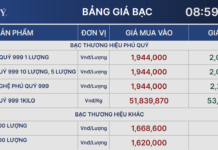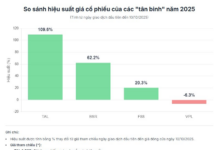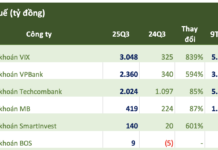Talking about the goal of becoming a high-income economy, a modern industry by 2030 and a developed country by 2045, Mr. Vo Tri Thanh stated: “Vietnam has many opportunities, advantages but also faces fierce competition. In the history of Vietnam’s reform and innovation, whenever it faces difficulties, there will be breakthroughs and new transformations. Although time is short, Vietnam can still achieve its goals by seizing the time and opportunities.”

Vietnam’s economy has passed more than 2 months of 2024, looking at the overall picture, what are the notable bright spots?
From 2022 to present, Vietnam’s economy has witnessed many positive changes. Firstly, the financial and monetary markets have shown better transformations. Specifically, in 2022, Vietnam faced tremendous pressure on exchange rates, interest rates, inflation, liquidity, and financial market shocks.
From 2023 to now, the macroeconomic situation and inflation have been controlled, the pressure on exchange rates and basic interest rates has decreased significantly, creating favorable conditions for monetary policy management. The State Bank of Vietnam has reduced interest rates 4 times and will maintain them in the first 6 months of 2024. The corporate bond market has shown more stability, although it has not met expectations.
Alongside this, various dimensions of total demand have shown more positive signs. In particular, exports that saw a significant decline (-11.9% in Q1/2023) decreased to only -4.4% for the whole year of 2023. Especially, in the first 2 months of 2024, it increased by 19.2% compared to the same period last year.

Behind that, the processing and manufacturing industry has also shown many signs of recovery: From a growth rate of -0.4% in Q1/2023 to 3.6% for the whole year of 2023. In the first 2 months of 2024, the industrial production index (IIP) increased by 5.9%.
Another indicator showing positive signals of industrial production is PMI. Almost every month in 2023 (except February and August), PMI was below 50, but in the first 2 months of 2024, it surpassed 50.
In addition to production and exports, foreign direct investment (FDI) and public investment have also achieved remarkable results. Specifically, FDI commitments and disbursements have continued to increase since the second half of 2023. The commitments and disbursements in 2023 reached USD 36.6 billion, an increase of 32.1% and USD 23.2 billion, an increase of 3.5%; the respective figures for the first 2 months of 2024 are USD 4.3 billion, an increase of 38.6% and USD 2.8 billion, an increase of 9.8%.
Regarding public investment, in 2023, the disbursement ratio reached a level that no one imagined, reaching VND 676,000 billion, equivalent to 95% of the plan, and increasing by VND 146,000 billion compared to 2022. In 2024, the disbursement of public investment will be strongly promoted right from the early months.
However, there is still a major concern, which is the confidence of the market and investors. In 2023, private investment slowed down, and the nominal statistics increased slightly, but when excluding price factors, it actually decreased to some extent.
In addition, according to statistical data, credit growth as of the end of February 2024 is still negative (-1.1%). Moreover, the real estate market has seen some “bumps” (transactions and liquidity) but overall has not fully recovered yet.
Especially, a driving force to maintain the growth is that consumer spending has a decreasing growth rate. In 2023, the total retail sales increased by 7.1%, significantly lower than the growth rate of 10.4% in Q1/2023. This number is about 5.0% in the first 2 months of 2024. It is noteworthy that consumer spending in 2023 was partly supported by the increase in foreign tourists visiting Vietnam.
In summary, Vietnam’s economic landscape has many bright spots, with difficult points tending to show more positive transformations, but market sentiment and consumer spending are still concerns.


Indeed, alongside the bright spots, the general assessment of experts and international organizations is that 2024 will still be a difficult year. How can market confidence be further strengthened in such difficult circumstances?
As I mentioned earlier, it can be seen very clearly that, up to now, market confidence and market movements, whether in the real estate market or private investment, have weakened. This is due to two reasons.
First, an open economy like Vietnam is subject to many impacts from the international environment, which is often described with three “insecurities”: instability, abnormality, and uncertainty. Another reason comes from the internal factors of the economy, typified by fluctuations in the financial and monetary markets.
It should also be noted that, although facing many difficulties, Vietnam, for the most part, still maintains macroeconomic stability. However, in a broader view, macroeconomic stability still faces major challenges in policy formulation, especially monetary policy. Specifically, Vietnam must maintain macroeconomic stability with relatively low inflation, a limited exchange rate “jumping”, and a sound balance of international payments.
Furthermore, the financial market, such as the bond and currency markets, is still not completely stable. While many banks meet Basel II standards, there are still banks that are not strong enough, even requiring special control. We have had a banking system restructuring program since 2012 and now have another program for the 2021-2025 period, which is a challenging process that requires a lot of effort.

Generally, we need to implement flexible monetary policies, keep up with the times, fully understand the goals and the nature of the economy. This can be understood as, in each stage, we have different solutions with different priorities.
For example, last year, we aimed for stable macroeconomic conditions and supported growth. As for this year, in the first six months, we did not change the base interest rate, focusing on supporting growth while maintaining macroeconomic stability. This shows the importance of goals in creating breakthroughs and spreading them wider.

In 2024, which sectors have the potential for positive growth?
The first sector that shows strong growth is agriculture. Some agricultural products such as rice, dragon fruit, and durian have good growth potential thanks to the increasing consumption trend in Vietnam. Among them, China is the largest agricultural product importer of Vietnam. When the Chinese market improves, Vietnamese agricultural exports will also benefit.
After agriculture is the processing and manufacturing industry, which continues to have positive growth prospects; orders from some industries have increased, such as the textile industry. This year, the textile industry aims to achieve the export value of 2019.
In addition, a sector that many people expect to warm up again is real estate. Currently, some believe that real estate may have more sunshine toward the end of this year, while others are more pessimistic, believing that it may have to wait until 2025. However, during the recent difficult period, there is still a segment with good growth, such as industrial real estate.

In the coming period, many concerns have been raised about Vietnam’s competitive advantages in the eyes of international investors, such as cheap labor, land, and tax incentives, gradually being diminished. According to you, how are Vietnam’s new competitive advantages being formed and what are the prospects?
In the past 5-7 years, the competitive advantage of attracting FDI has been closely linked to the global restructuring of supply chains and the development of the digital economy and green economy. This has been of particular interest in the context of geopolitical dynamics.
The core competitive advantage in attracting investment includes 3 groups of factors that need special attention. Firstly, there are traditional factors such as political and macroeconomic stability, comparative advantages such as labor costs, good connectivity such as multiple free trade agreements (FTAs), favorable geographical location, and low transaction costs (especially related to the business environment and administrative procedures).
Secondly, there is the ability to keep pace with trends. In reality, in addition to comparative advantages…, investors are particularly interested in technological capacity, digital environment, green environment, the availability of high-quality labor supply, and the ability to attract global experts and talent.
Lastly, but equally importantly, is the resilience of the economy and, in particular, the confidence of partners, having sufficient stability and reliability in the face of global competition and fluctuations in the geopolitical situation.
Overall, Vietnam has certain advantages in attracting FDI, especially strategic investors. Of course, competition among countries in the region and around the world is fierce, and we still need to make more effort to create true attractiveness for high-quality capital and investment flows. The figures for attracting FDI in 2023 and the early months of 2024 somewhat reflect the fact that foreign investors still pay great attention to Vietnam.
Vietnam’s economic growth in 3 consecutive years has not reached the overall target of the 5-year plan for 2021-2025 (6.5 – 7%) and the 10-year strategy for 2021-2030 (about 7%). So what opportunities does Vietnam have to make a turning point for the economy in 2024, to achieve the goals of this term and lay a foundation for 2025-2030?

In the 2021-2025 period, Vietnam has faced unprecedented difficulties. Despite that, Vietnam has still created new growth momentum to propel the economy forward. There are things that we have not achieved as expected, but there are still some goals that have achieved good results in this period.
However, the average growth rate of 6.5-7% during the 2021-2025 period is still a huge challenge. As announced, the growth rate in 2021 was low due to the global pandemic, reaching 2.58%, in 2022 the growth rate reached 8.02%, and in 2023, it reached 5.05%. Thus, in accordance with the 5-year plan, the growth rates in 2024 and 2025 must be above 8% per year, which is a very high number in the current circumstances.
Speaking about the 2025-2030 plan, Vietnam aims to become a high-income country by 2030. I am confident that we will achieve this goal. Because Vietnam’s GDP per capita in 2023 has exceeded $4,284, approaching the threshold of a high-income economy.
The issue of concern is that we are facing the challenge of increasing labor productivity and the contribution of productivity. Specifically, labor productivity growth in the past 3 years has been below 5%, much lower than the target (at least 6.5%) and expectations.
To boost labor productivity, technology and skills are crucial factors. Therefore, we need to industrialize, modernize, focus on innovation and reform of education and training, and be determined and resolute to create momentum for increased productivity and economic growth.
In particular, this contributes to creating a foundation for Vietnam to prove itself as an attractive destination for high-quality investors. When becoming a convergence point for new FDI flows, Vietnamese enterprises themselves will have more opportunities to innovate and continue to create new driving forces for growth.
In addition to technology and skills, another equally important factor is time. Time waits for no one, and Vietnam needs to take advantage of time, carry out reforms resolutely, quickly, and create people who are diligent, proactive, creative, and willing to take responsibility to create a new turning point. By doing so, even amidst the current global situation with many fluctuations, Vietnam’s economy will still thrive.

As you mentioned, the goal is very challenging, and time is in short supply. So where do the opportunities to achieve the large goals of this period come from?
In the 2021-2030 period, Vietnam has a great advantage, which is an enthusiastic desire to become a developed country that spans generations, from policy-makers, experts, scientists to young people. And even in the most difficult times, I still see this burning aspiration.
Along with that, the second advantage is that Vietnam is always ready to face challenges, make reforms, and solve problems immediately. While many people were anxious and afraid, seeking security for themselves when facing the war against corruption and problems of the system, we looked directly at the problem, solving it step by step.
However, one thing to note is, in the past, during the Renovation period, reforms were very difficult, so we need to start with pilot programs, take small steps. Now that we have more experience, we need to learn from past lessons, implement faster and better to create more breakthroughs and wider impacts.
It is thanks to these important steps that Vietnam does not only hope but is actually gradually approaching the goal of becoming a developed country.
Thank you!


































